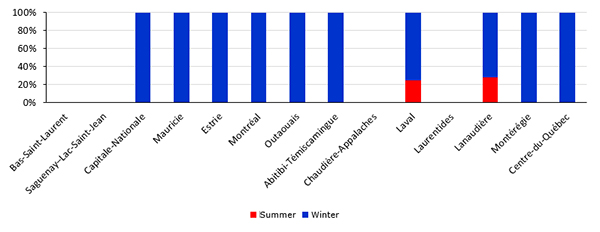
Annual statistics
Smog days
A smog day is a day in which air emissions and weather conditions result in the formation of high concentrations of fine particulates and/or ozone over a large area, lasting many hours. The following three criteria are used to define and determine smog days:
- Intensity: The hourly concentration of fine particulates over a three-hour period of time must exceed 35 micrograms per cubic metre (µg/m3) or the concentration of ozone must exceed 82 parts per billion (ppb).
- Duration: The high concentrations (in excess of 35 µg/m3 for fine particulates or 82 ppb for ozone) must be observed for at least three hours.
- Dispersion: The high concentrations must be representative of the administrative region.
Number of fog days, by administrative region (2004–2023)
Administrative Region |
2004 | 2005 | 2006 | 2007 | 2008 | 2009 | 2010 | 2011 | 2012 | 2013 | 2014 | 2015 | 2016 | 2017 | 2018 | 2019 | 2020 | 2021 | 2022 | 2023 |
|---|---|---|---|---|---|---|---|---|---|---|---|---|---|---|---|---|---|---|---|---|
| Abitibi-Témiscamingue | ND | ND | 2 | 7 | 0 | 1 | 3 | 2 | 2 | 1 | 1 | 0 | 0 | 0 | 2 | 2 | 1 | 8 | 1 | 29 |
| Bas-Saint-Laurent | ND | 4 | 2 | 3 | 0 | 0 | 2 | 0 | 0 | 2 | 0 | 1 | 0 | 0 | 1 | 0 | 0 | 1 | 0 | 7 |
| Capitale-Nationale | 15 | 21 | 10 | 6 | 2 | 3 | 9 | 2 | 12 | 11 | 8 | 11 | 3 | 1 | 9 | 5 | 19 | 15 | 11 | 12 |
| Centre-du-Québec | 8 | 14 | 7 | 8 | 2 | 3 | 6 | 3 | 6 | 5 | 0 | 3 | 0 | 1 | 0 | 2 | 5 | 7 | 1 | 13 |
| Chaudière-Appalaches | 5 | 11 | 4 | 4 | 0 | 1 | 0 | 0 | 0 | 2 | 0 | 0 | 0 | 0 | 0 | 0 | 1 | 4 | 0 | 5 |
| Estrie | 6 | 15 | 5 | 6 | 0 | 1 | 2 | 1 | 0 | 1 | 0 | 0 | 0 | 0 | 0 | 1 | 0 | 4 | 2 | 7 |
| Lanaudière | 10 | 22 | 5 | 8 | 8 | 19 | 13 | 17 | 13 | 7 | 1 | 11 | 1 | 8 | 7 | 2 | 10 | 6 | 7 | 14 |
| Laurentides | 9 | 15 | 1 | 5 | 1 | 1 | 4 | 0 | 0 | 3 | 1 | 0 | 0 | 0 | 0 | 0 | 0 | 3 | 0 | 11 |
| Laval | 21 | 34 | 10 | 13 | 10 | 29 | 18 | 14 | 18 | 6 | 5 | 9 | 7 | 7 | 9 | 5 | 9 | 4 | 4 | 4 |
| Mauricie | 11 | 19 | 4 | 5 | 3 | 12 | 6 | 5 | 7 | 7 | 0 | 5 | 6 | 5 | 2 | 6 | 9 | 4 | 4 | 9 |
| Montérégie | 16 | 28 | 7 | 7 | 5 | 11 | 8 | 8 | 14 | 7 | 7 | 7 | 1 | 3 | 3 | 0 | 6 | 6 | 1 | 11 |
| Montréal | 24 | 34 | 11 | 15 | 30 | 35 | 26 | 21 | 19 | 13 | 9 | 5 | 8 | 7 | 6 | 6 | 10 | 7 | 4 | 12 |
| Outaouais | 9 | 19 | 5 | 6 | 0 | 3 | 3 | 0 | 0 | 2 | 0 | 0 | 0 | 0 | 0 | 0 | 0 | 2 | 1 | 11 |
| Saguenay–Lac-Saint-Jean | 4 | 8 | 1 | 3 | 0 | 0 | 0 | 1 | 0 | 1 | 0 | 2 | 0 | 0 | 0 | 0 | 0 | 5 | 0 | 16 |
ND = no data
In 2023, the number of smog days ranged between 4 and 29 depending on the region. The highest number of smog days was observed in the Abitibi-Témiscamingue region.
Average annual number of smog days (2004–2023)
Compared to previous years, the average number of smog days (11.5) increased in 2023. The forest fires in summer 2023 (French) are wholly responsible for this increase. They caused all of the smog days recorded during the summer season (May to October), which represent 88% of all smog days recorded in 2023. In 2022, the percentage of smog days during the summer was 8.3%.
Ratio of number of smog days by period in 2023

As is the case each year, cold temperatures (French) also had an impact on results in major urban areas due to residential wood heating.
The result for the Capitale-Nationale region is a good example of the impact of residential wood heating on air quality. The five smog days recorded during winter (November–April) are consistent with the typical wood heating pattern. In addition, none of these occurrences had an impact beyond the boundaries of Québec City, which confirming their local origin.
Ozone has not been a factor in any smog day since 2017.
Learn more at Poor air quality statistics.
